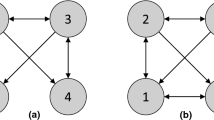Abstract
Uniform sequential continuity, a property classically equivalent to sequential continuity on compact sets, is shown, constructively, to be a consequence of strong continuity on a metric space. It is then shown that in the case of a separable metric space, uniform sequential continuity implies strong continuity if and only if one adopts a certain boundedness principle that, although valid in the classical, recursive and intuitionistic setting, is independent of Heyting arithmetic.
Similar content being viewed by others
References
Beeson, M. J.: `The nonderivability in intuitionistic formal systems of theorems on the continuity of effective operations'. J. Symb. Logic 40, 321–346 (1975)
Beeson, M. J.: Foundations of Constructive Mathematics. Springer–Verlag, Heidelberg, 1985
Bishop, E.: Foundations of Constructive Analysis. McGraw–Hill, New York, 1967
Bishop, E., Bridges, D.: Constructive Analysis. Grundlehren der Math. Wissenschaften 279, Springer–Verlag, Heidelberg, 1985
Bridges, D., van Dalen, D., Ishihara, H.: `Ishihara's proof technique in constructive analysis'. Indag. Math. 13, 433–440 (2002)
Bridges, D., Richman, F.: Varieties of Constructive Mathematics. London Math. Soc. Lecture Notes 97, Cambridge: Cambridge University Press, 1987
Bridges, D., Mines, R.: `Sequentially continuous linear mappings in constructive analysis'. J. Symb. Logic 63, 579–583 (1998)
Bridges, D., Ishihara, H., Schuster, P.: `Sequential compactness in constructive analysis'. Österreich. Akad. Wiss. Math.-Natur. Kl. Sitzungsber. II 208, 159–63 (1999)
Bridges, D., Ishihara, H., Schuster, P.: `Compactness and continuity, constructively revisited'. In: Computer Science Logic (J. Bradfield, ed; Proceedings of 16th International Workshop CSL 2002, 11th Annual Conference of the EACSL, Edinburgh, Scotland, September 22–25), Lecture Notes in Computer Science 2471, 89–102, Springer–Verlag, Berlin and Heidelberg, 2002
Bridges, D., Vîţă, L.: `Apartness spaces as a framework for constructive topology'. Ann. Pure Appl. Logic. 119 (1–3), 61–83 (2003)
Cameron, P., Hocking, J.G., Naimpally, S.A.: `Nearness, a better approach to continuity and limits, Part II'. Mathematics Report #18–73, Lakehead University, Ontario, Canada, 1973
Dummett, M.: Intuitionism: An Introduction (2nd Edn). Oxford University Press, 2000
Ishihara, H.: `Continuity and nondiscontinuity in constructive mathematics'. J. Symb. Logic 56, 1349–1354 (1991)
Ishihara, H.: `Continuity properties in constructive mathematics'. J. Symb. Logic 57, 557–565 (1992)
Ishihara, H.: `Markov's principle, Church's thesis and Lindelöf's theorem'. Indag. Mathem., N.S. 4, 321–325 (1993)
Ishihara, H.: `A constructive version of Banach's inverse mapping theorem'. New Zealand J. Math 23, 71–75 (1994)
Ishihara, H.: `Sequential continuity in constructive mathematics'. In: Combinatorics, Computability and Logic (Proceedings of DMTCS'01, Constanţa, Romania, 2–6 July 2001; Calude, C.S., Dinneen, M.J., Sburlan, S. (eds.)), 5–12, DMTCS Series 17, Springer–Verlag, London, 2001
Ishihara, H., Schuster, P.: `A constructive uniform continuity theorem'. Quarterly J. Math. 53, 185–193 (2002)
Ishihara, H., Yoshida, S.: `A constructive look at the completeness of
 J. Symb. Logic 67, 1511–1519 (2002)
J. Symb. Logic 67, 1511–1519 (2002)Kushner, B. A.: Lectures on Constructive Mathematical Analysis. Amer. Math. Soc., Providence RI, 1985
Schuster, P. M.: `Elementary choiceless constructive analysis'. In: Computer Science Logic (Proceedings of Conference in Fischbachau, August 2000; P. Clote, H. Schwichtenberg, eds), Lecture Notes in Computer Science 1862, 512–526, Springer–Verlag, Berlin, 2000
Schuster, P., Vîţă, L., Bridges, D.: `Apartness as a relation between subsets'. In: Combinatorics, Computability and Logic (Proceedings of DMTCS'01, Constanţa, Romania, 2–6 July 2001; Calude, C.S., Dinneen, M.J., Sburlan, S. (eds.)), 203–214, DMTCS Series 17, Springer–Verlag, London, 2001
Schuster, P. M.: `Unique existence, approximate solutions, and countable choice'. Theor. Comp. Sci. 305, 433–455 (2003)
Troelstra, A. S., van Dalen, D.: Constructivism in Mathematics: An Introduction (two volumes). North Holland, Amsterdam, 1988
Weihrauch, K.: `A foundation for computable analysis'. In: Combinatorics, Complexity, & Logic(Proceedings of Conference in Auckland, 9–13 December 1996; Bridges, D.S., Calude, C.S., Gibbons, J., Reeves, S., Witten, I.H. (eds)), Springer–Verlag, Singapore, 1996
Author information
Authors and Affiliations
Corresponding author
Rights and permissions
About this article
Cite this article
Bridges, D., Ishihara, H., Schuster, P. et al. Strong continuity implies uniform sequential continuity. Arch. Math. Logic 44, 887–895 (2005). https://doi.org/10.1007/s00153-005-0291-1
Received:
Published:
Issue Date:
DOI: https://doi.org/10.1007/s00153-005-0291-1





 J. Symb. Logic 67, 1511–1519 (2002)
J. Symb. Logic 67, 1511–1519 (2002)